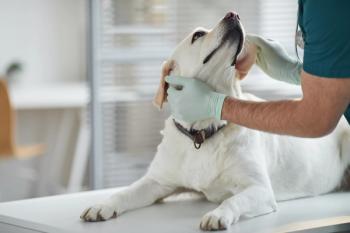
Progress in the diagnosis and management of canine hypothyroidism (Proceedings)
Canine hypothyroidism is one of the more common endocrine diseases seen by small animal clinicians. As thyroid screening has become more frequently utilized, practitioners have become more aware of the frequency with which hypothyroidism occurs.
Canine hypothyroidism is one of the more common endocrine diseases seen by small animal clinicians. As thyroid screening has become more frequently utilized, practitioners have become more aware of the frequency with which hypothyroidism occurs. Because thyroid disorders typically respond well to treatment and carry a good prognosis, it is important for the clinician to be aware of the common clinical signs as well as the unusual manifestations of canine hypothyroidism and to routinely screen patients with suspected or potential thyroid disease.
Testing for canine hypothyroidism is indicated in dogs with historical and clinical signs consistent with hypothyroidism; potential candidates for thyroid screening include dogs with unexplained lethargy or weight gain, poor haircoat, recurrent skin or ear infections, chronic seborrheic dermatitis, elevated cholesterol, cold intolerance, neuromuscular disorders or behavioral changes. In addition, the overall incidence of canine hypothyroidism is such that T4 determination may be included as part of a routine canine geriatric screening panel. In-house T4 testing can offer a convenient alternative for the determination of T4 levels for the diagnosis of canine hypothyroidism and for monitoring T4 levels during therapy.
The recommended initial data base for the dog with suspected hypothyroidism consists of a serum T4 level and a CBC, chemistry profile and urinalysis. Results of the CBC and chemistry profile can be extremely helpful in evaluating the dog with suspected hypothyroidism. Findings such as hypercholesterolemia and mild anemia will increase the index of suspicion for the disorder. In addition, thetests are useful in excluding nonthyroidal illness (NTI). Moderate to severe NTI can lower the T4 level well below the normal range, and can affect other tests of thyroid function as well. No test of thyroid function is perfect and NTI can adversely affect all of them, making interpretation of results difficult. Care must be taken to exclude NTI and thyroid testing of sick dogs should be avoided if possible. The results of thyroid function tests, including T4 levels, must be interpreted in light of the patient's history and physical examination and the results of the minimum data base. For example, a borderline low T4 in a dog with a classical presentation, hypercholesterolemia and mild anemia is more significant than the same result in a dog with atypical clinical findings, a normal cholesterol and evidence of NTI on the accompanying tests. It should also be remembered that older dogs and sight hounds of any age tend to have lower T4 concentrations. Rarely, dogs with hypothyroidism have circulating anti-T4 antibodies that are measured as T4 by many assays resulting in falsely elevated T4 levels (but usually above the reference range). Several commonly administered drugs can alter T4 levels, often into the hypothyroid range, and the results of other thyroid tests as well. Glucocorticoids will usually lower T4 concentrations especially if high doses have been given, but may also do so in some patients receiving modest dosages. Phenobarbital has also been shown to significantly lower T4 levels. One report demonstrated that 40% of dogs had low T4 levels after receiving phenobarbital. Trimethoprim/sulfa antibiotics have also been shown to interfere with thyroid hormone metabolism and lower serum T4 levels. Many other drugs have been shown to alter thyroid hormone parameters in humans. Until data is available to demonstrate similar effects in veterinary patients, thyroid hormone levels in patients receiving these medications should be interpreted cautiously. Thyroid testing in animals being administered drugs that alter or have the potential to alter thyroid hormone levels should be delayed until a few to several weeks after discontinuing the medication. In those patients in which the potentially interfering drug cannot be discontinued, the thyroid test results must be evaluated with the possible effects of the concurrent medication in mind. Dogs being evaluated for breeding and the potential of hereditary autoimmune thyroid disease should have a free T4 by dialysis, a serum TSH level and an antithyroglobulin autoantibody level determined in addition to a T4 level. Preliminary data indicates that elevations in antithyroglobulin autoantibodies may precede the development of overt hypothyroidism in some dogs and thus may serve as a marker for the disorder. Recent data suggest that approximately 20% of dogs with laboratory test evidence to suggest subclinical thyroiditis, develop thyroid dysfunction within one year.
A T4 >2 mg/dl and within the reference range, with few exceptions, excludes hypothyroidism. This means that a T4 level of this magnitude is very useful in excluding the diagnosis of hypothyroidism. Dogs with low T4 levels or dogs with low-normal T4 levels in which the disease is still suspected will require additional testing to confirm the diagnosis. The tests of choice to confirm hypothyroidism are determination of serum TSH and free T4 (fT4) levels. The dialysis methodology for determining fT4 is preferred over RIA or analogue procedures. However, at this writing the dialysis test is not available and other methods of free T4 determination are being evaluated. An elevated TSH level and a decreased fT4 level are consistent with hypothyroidism. Approximately 25 per cent of dogs with confirmed hypothyroidism will have a normal serum TSH level. Therefore, the current recommendation is to run a serum TSH level and a fT4 level in tandem to confirm the diagnosis of hypothyroidism. Performing a TSH response test using recombinant human TSH can be considered in some cases. Although less ideal, a clinical trial using a name brand thyroxine preparation can serve to confirm the diagnosis, so long as resolution of clinical signs is seen after 6 to 8 weeks of appropriate therapy (as confirmed with therapeutic monitoring of T4 levels) followed by recurrence of clinical signs after discontinuation of therapy.
The most important parameter in assessing response to thyroid replacement therapy is resolution of clinical signs. Name-brand preparations are recommended. A liquid thyroxine preparation is available and may be useful in some cases. Therapeutic monitoring of thyroid hormone levels is extremely helpful in assuring appropriate dosing and a prompt response to treatment and is strongly recommended. Ideally, both peak and trough levels of T4 and T3 would be determined. Practically, however, one usually determines the peak or trough T4 level during therapeutic monitoring of hypothyroidism. One must remember that T4 results can vary somewhat, and sometimes significantly, between testing methodologies and even from laboratory to laboratory using the same assay. Ideally, the same methodology and/or laboratory should be used for all followup monitoring unless unexpected or confusing results are being obtained. If the importance, logistics and schedule of therapeutic monitoring are explained to clients, most are willing to have the necessary follow-up labwork performed. All dogs are initially given thyroxine twice daily. In some dogs, only once daily thyroxine is needed during long-term therapy while others continue to need twice daily administration. Six weeks after initiating treatment, either the peak or trough T4 level (or both) is determined. The choice of peak or trough sampling is dependent on the client's and veterinarian's schedule. The desired post-pill thyroid hormone level(s) will depend on the timing of the blood sample. Serum for peak levels is drawn 4 to 6 hours after thyroxine administration, whereas serum for trough levels is drawn immediately prior to the next dose. Peak levels should be high-normal to slightly increased and trough levels should be low-normal. Thyroid hormone levels should be determined 6 weeks after any change in dosage, administration frequency or brand of thyroxine supplementation. Thyroid hormone levels are determined at 3 and 6 months of therapy and ideally every 6 months thereafter to assure proper dosing and to allow for early detection of undertreatment or iatrogenic hyperthyroidism.
Newsletter
From exam room tips to practice management insights, get trusted veterinary news delivered straight to your inbox—subscribe to dvm360.






